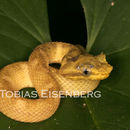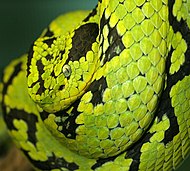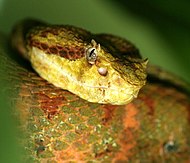en
names in breadcrumbs


Bothriechis is a genus of venomous pit vipers, commonly called palm vipers[2] or palm-pitvipers[3] found predominantly in Mexico and Central America, although the most common species, B. schlegelii, ranges as far south as Colombia and Peru.[4] All members are relatively slender and arboreal. The name Bothriechis is derived from the Greek words bothros and echis that mean "pit" and "viper" respectively.[3] Ten species and no subspecies are currently generally recognized.[5][6]
Species that belong to this genus typically reach lengths of 60–80 cm, while B. aurifer, B. bicolor and B. lateralis are known to grow to 1 m or more.[3]
General characteristics include a sharply defined canthus rostralis, an unelevated snout, a rostral scale that is not as high as it is broad, and a prehensile tail that accounts for at least 15% of the body length.[3]
The color pattern usually consists of a green ground color that may or may not include pale or dark markings. B. schlegelii is an exception to this rule.[3]
Occurs in southern Mexico (southeastern Oaxaca and the northern highlands of Chiapas), through Central America to northern South America (Colombia, western Venezuela, Ecuador and northern Peru).[1]
As a general rule, species found above 1,500 meters altitude tend to be diurnal, while those found below 1,000 meters tend to be active at night. Those found between 1,000 and 1,500 meters may be active at any time of the day.[3]
Bothriechis venom is primarily a haemotoxin which causes severe pain, swelling, bleb formation, bruising, and quite often necrosis. If untreated it can lead to loss of a limb, or even death. Each year several farmers and plantation workers are bitten by eyelash vipers, sometimes resulting in fatalities. Wyeth in the United States and Instituto Clodomiro Picado in Costa Rica both manufacture different polyvalent antivenins which can be used to treat eyelash viper envenomations.
There are 11 recognized species.[7]
Image Species[5] Taxon author[5] Common name[3] Geographic range[1] B. aurifer (Salvin, 1860) Yellow-blotched palm-pitviper Mexico, in the mountains of eastern Chiapas, in northern Guatemala. Occurs in cloud forest at 1200–2300 m altitude.
B. aurifer (Salvin, 1860) Yellow-blotched palm-pitviper Mexico, in the mountains of eastern Chiapas, in northern Guatemala. Occurs in cloud forest at 1200–2300 m altitude.  B. bicolor (Boucourt, 1868) Guatemalan palm-pitviper The Pacific slope of southeastern Chiapas in Mexico, eastward to south-central Guatemala. Also known from several locations in Honduras, including the southern part of the Sierra del Merendón and Cerro Santa Bárbara. Occurs in cloud forests at 500–2000 m altitude.
B. bicolor (Boucourt, 1868) Guatemalan palm-pitviper The Pacific slope of southeastern Chiapas in Mexico, eastward to south-central Guatemala. Also known from several locations in Honduras, including the southern part of the Sierra del Merendón and Cerro Santa Bárbara. Occurs in cloud forests at 500–2000 m altitude.  B. guifarroi Townsend, Medina-Flores,
B. guifarroi Townsend, Medina-Flores, B. lateralis W. Peters, 1862 Side-striped palm-pitviper The mountains of Costa Rica and western Panama, including the Cordillera de Tilarán, the Cordillera Central and the Cordillera de Talamanca to the provinces of Chiriquí Province and Veraguas. Occurs at 850–980 m altitude. B. marchi (Barbour & Loveridge, 1929) Honduran palm-pitviper The Atlantic versant of northwestern Honduras and eastern Guatemala. Occurs in mesic forest at elevations of 500–1500 m altitude.
B. lateralis W. Peters, 1862 Side-striped palm-pitviper The mountains of Costa Rica and western Panama, including the Cordillera de Tilarán, the Cordillera Central and the Cordillera de Talamanca to the provinces of Chiriquí Province and Veraguas. Occurs at 850–980 m altitude. B. marchi (Barbour & Loveridge, 1929) Honduran palm-pitviper The Atlantic versant of northwestern Honduras and eastern Guatemala. Occurs in mesic forest at elevations of 500–1500 m altitude.  B. nigroviridisT W. Peters, 1859 Black-speckled palm-pitviper The mountains of Costa Rica and Panama. Also found in the cloud forests of the Cordillera Central and the Cordillera de Talamanca at 1150–2400 m altitude. B. nubestris Doan, Mason, Castoe, Sasa, & Parkinson, 2016 Talamancan palm-pitviper Costa Rica. San Isidro de El General, Province of San José at approximately 3000 m altitude.
B. nigroviridisT W. Peters, 1859 Black-speckled palm-pitviper The mountains of Costa Rica and Panama. Also found in the cloud forests of the Cordillera Central and the Cordillera de Talamanca at 1150–2400 m altitude. B. nubestris Doan, Mason, Castoe, Sasa, & Parkinson, 2016 Talamancan palm-pitviper Costa Rica. San Isidro de El General, Province of San José at approximately 3000 m altitude.  B. rowleyi (Bogert, 1968) Mexican palm-pitviper Mexico in southeastern Oaxaca and northern Chiapas. Occurs in cloud forests at 1500–1830 m altitude.
B. rowleyi (Bogert, 1968) Mexican palm-pitviper Mexico in southeastern Oaxaca and northern Chiapas. Occurs in cloud forests at 1500–1830 m altitude.  B. schlegelii (Berthold, 1846) Eyelash palm-pitviper From southern Mexico (northern Chiapas), southeastward on the Atlantic slope and lowlands through Central America to northern South America in Colombia and Venezuela. Also found on the Pacific versant and lowlands in parts of Costa Rica, Panama, Colombia, Ecuador and Peru. Occurs in mesic forest at elevations almost from sea level to 2640 m altitude.
B. schlegelii (Berthold, 1846) Eyelash palm-pitviper From southern Mexico (northern Chiapas), southeastward on the Atlantic slope and lowlands through Central America to northern South America in Colombia and Venezuela. Also found on the Pacific versant and lowlands in parts of Costa Rica, Panama, Colombia, Ecuador and Peru. Occurs in mesic forest at elevations almost from sea level to 2640 m altitude.  B. supraciliaris (Taylor, 1954) Blotched palm-pitviper Only found in a mountainous area in southwestern Costa Rica. Occurs in lower montane wet forest and cloud forest at elevations from 800 m to 1,700 m.[9]
B. supraciliaris (Taylor, 1954) Blotched palm-pitviper Only found in a mountainous area in southwestern Costa Rica. Occurs in lower montane wet forest and cloud forest at elevations from 800 m to 1,700 m.[9]  B. thalassinus Campbell & E.N. Smith, 2000 Merendon palm-pitviper Guatemala, Honduras at 1370–1750 m altitude.
B. thalassinus Campbell & E.N. Smith, 2000 Merendon palm-pitviper Guatemala, Honduras at 1370–1750 m altitude. A new species from Guatemala and Honduras, B. thalassinus, was described by Campbell & E.N. Smith (2000). Campbell & Lamar (2004) recognize this species, as well as a ninth addition to the genus: B. supraciliaris, which was first described by Taylor (1954) as a subspecies of B. schlegelii, and is found in southwestern Costa Rica.[3]
B. guifarroi was discovered in 2010 and described by Townsend et al. in 2013, in a study that included the following suggested phylogenetic tree of the genus:[6]
BothriechisB. schlegelli (Ecuador)
B. supraciliaris
B. schlegelli (Costa Rica, Honduras, Nicaragua)
B. nigroviridis
B. lateralis
B. guifarroi
B. marchi (Honduras, Guatemala)
B. thalassinus
B. bicolor
B. aurifer
B. rowleyi
Bothriechis is a genus of venomous pit vipers, commonly called palm vipers or palm-pitvipers found predominantly in Mexico and Central America, although the most common species, B. schlegelii, ranges as far south as Colombia and Peru. All members are relatively slender and arboreal. The name Bothriechis is derived from the Greek words bothros and echis that mean "pit" and "viper" respectively. Ten species and no subspecies are currently generally recognized.